I’ve always loved the Legend of Zelda’s protagonist. He might not say a lot, but he’s the kind of hero you can really look up to.
In today’s world of dark, flawed heroes, a true hero like Link or Captain America is a breath of fresh air. He’s never mean, cruel or spiteful and—despite going through tragedies that might break a lesser man (or boy)—he never gives up or caves in to evil. Aside from the occasional, harmless destruction of property, Link always does the right thing, even when it means things will get harder before they get better.
As much as I love the Legend of Zelda franchise and it’s chief protagonist, however, I’ve never really imagined Link or the world of Hyrule as a cartoon universe. Sure, that’s how it’s depicted, but a cartoon drawing is a representation of how something looks, not how it actually looks.
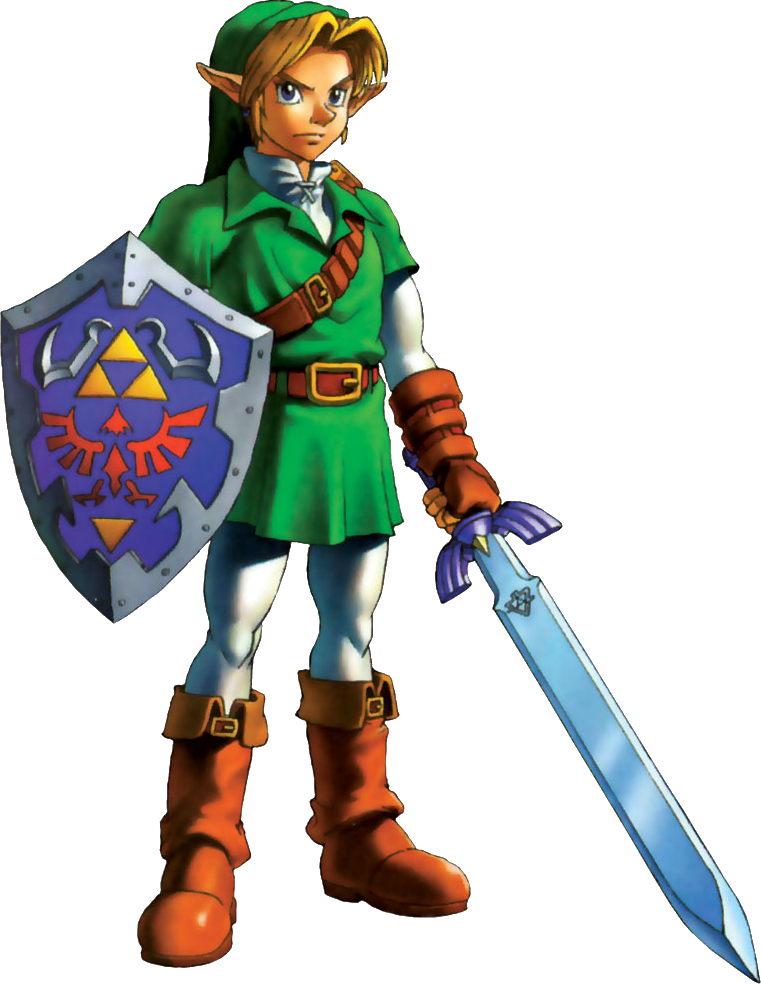
Nobody looks like this in real life…image from Character Profile Wikia.
To me, the real Link was always a real life (if a bit larger-than-life) sort of hero. He lived in a real world and fought real enemies. Sure, he looked like a slender teenage boy in the games, but in reality, he was a real man.
I mean, the guy plays Whack-a-Mole with dragons! That’s not exactly what you expect from a 15-year-old in tights.

So, when I finally got around to making my own Link costume, this was the version of Link I wanted to depict. My Link wouldn’t be a kid in a brightly colored tunic, he’d be a fully-grown warrior.
Link in Real Life
Let’s face it, there are a lot of amazing Link cosplays out there. However, after looking through countless cosplay photos, something kept bugging me. The very best, most game-accurate cosplays always ended up being portrayed by females.
For example, check out this amazing Link cosplay by LiKovacs:
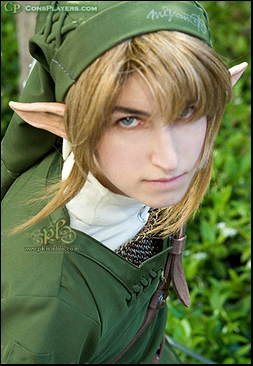
The detail work on her costume is amazing, her face looks just like Link’s face. In fact, you could have sworn she stepped right out of the Twilight Princess.
And that was the problem.
As game-accurate as these Link cosplays were, they still had that cartoonish quality to them. They didn’t sell you on the idea that this Link was the kind of manly warrior who could go toe-to-toe with the deadliest creatures in Hyrule.
Both for variety’s sake and to stay true to my vision, I wanted to do something different.
So, I turned to Hollywood for inspiration. Whether it’s superhero movies or anime adaptations, Hollywood has been turning cartoons into real life for decades and they had faced many of the same problems I was facing.
And, somewhere between Adam West’s Batman and Christian Bale’s Batman, Hollywood realized that real people don’t look very real when you dress them up in a cartoon costume:

Image by ChopArt2012.
Instead, if you want a cartoon character to look “real” on screen, you have to completely reimagine the character’s design. Instead of trying to create something that looks like a depiction of real life, you have to assume that character created their own costume in real life. Yes, you can include various elements that evoke or pay homage to the cartoon costume, but you have to start from real life—not cartoon life.
With that in mind, I started thinking about the world of Hyrule and the time period it generally resembles. Although the world of the Legend of Zelda franchise has many obvious Asian influences, at its core, Link’s world is based on medieval Europe. The more I thought about it, the more I liked the idea of the real-life Legend of Zelda taking place in medieval Ireland.
After all, the early Celts even had a holy symbol that strongly resembled the Triforce, the “triquetra” or Celtic knot:

And, Link’s classic outfit happens to look an awful lot like everyday wear for a Celtic man:
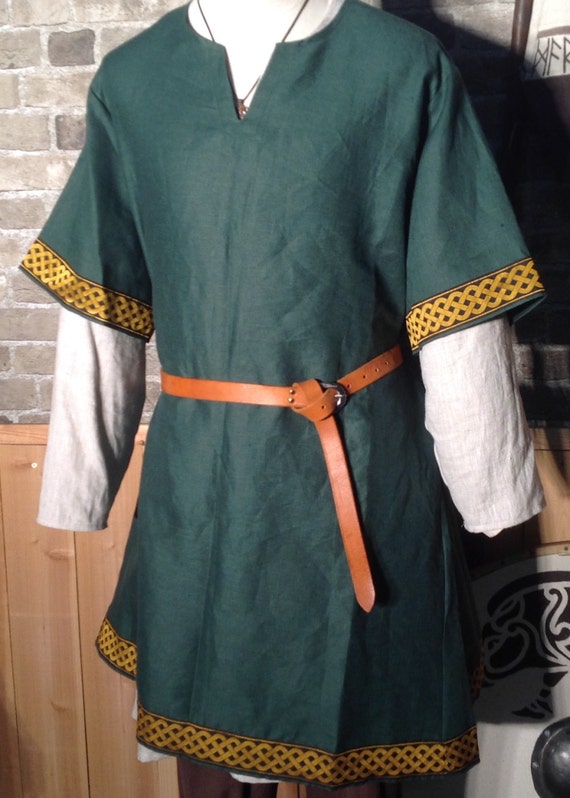
I could go on and on about the similarities between the world of Hyrule and medieval Celts, but we’ll leave that for another article. However, now that I knew what time period my Link costume was hailing from, I could start creating a version of Link that was based on a real life culture and clothing.
Link’s Tunic
Referring back to Hollywood, if there’s one thing Hollywood consistently loves to do when they translate cartoon into real life, it’s to add leather.
Take the X-Men, for example. Here’s what they look like in the comics:
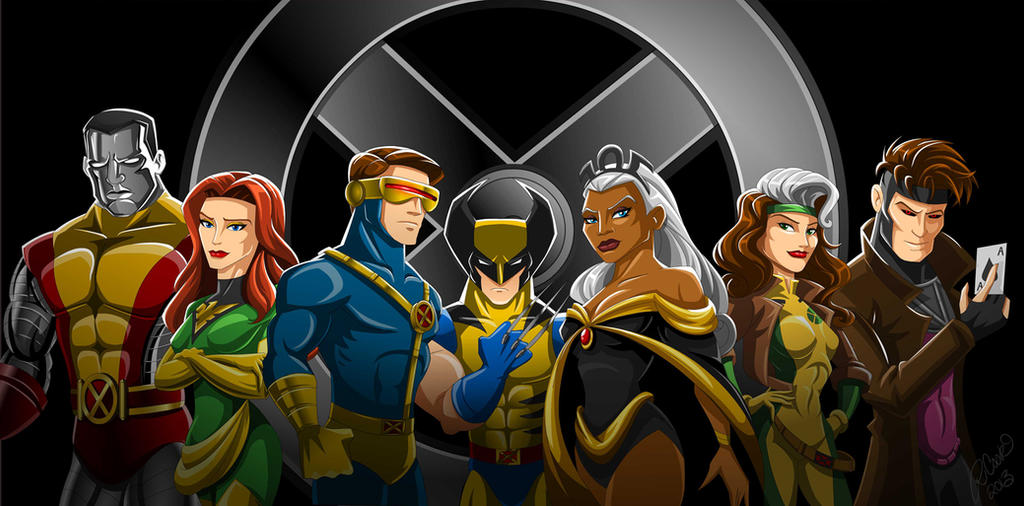
Image by Wil-Woods.
…and here’s what they look like in the movies:

What’s the difference? Leather, lots and lots of leather.
Now, I’ll admit, I’ve loved leather ever since I insisted that my mom buy me a leather jacket for my first cosplay costume. Leather just looks, feels and even smells real.
To make things even better, leather is tough and protective. If you treat it right, it can handle all sorts of wear, tear and damage—just the sort of qualities you’d expect from Link’s tunic.
As an added bonus, I wanted Link’s tunic to have some wear and tear and nothing shows authentic wear and tear better than leather.
With all that in mind, when it came time to make my Link cosplay, I knew I wanted the tunic to be leather. I started looking into various Celtic tunic and leather designs and finally settled on one that interwove various long strips of leather together.
This added a nice level of detailing to the tunic and also seemed rather practical, since it would give Link the ability to swap out pieces of leather if part of the tunic was damaged in combat.

Climbing up a 30-ft cliff in full costume!
The finished piece not only looked like something you’d expect a medieval warrior like Link to actually wear, it was also extremely practical. I’ve literally climbed cliffs and walls, hiked miles through the mountains, leapt off buildings and fought armed enemies in this cosplay (which helps explain the natural wear and tear in the above photo) and I’ve never had any issues with either mobility or durability in this tunic.
Link’s Arming Shirt and Chainmaille
One of the fundamental elements of Link’s “look” is the white shirt he wears under his tunic.
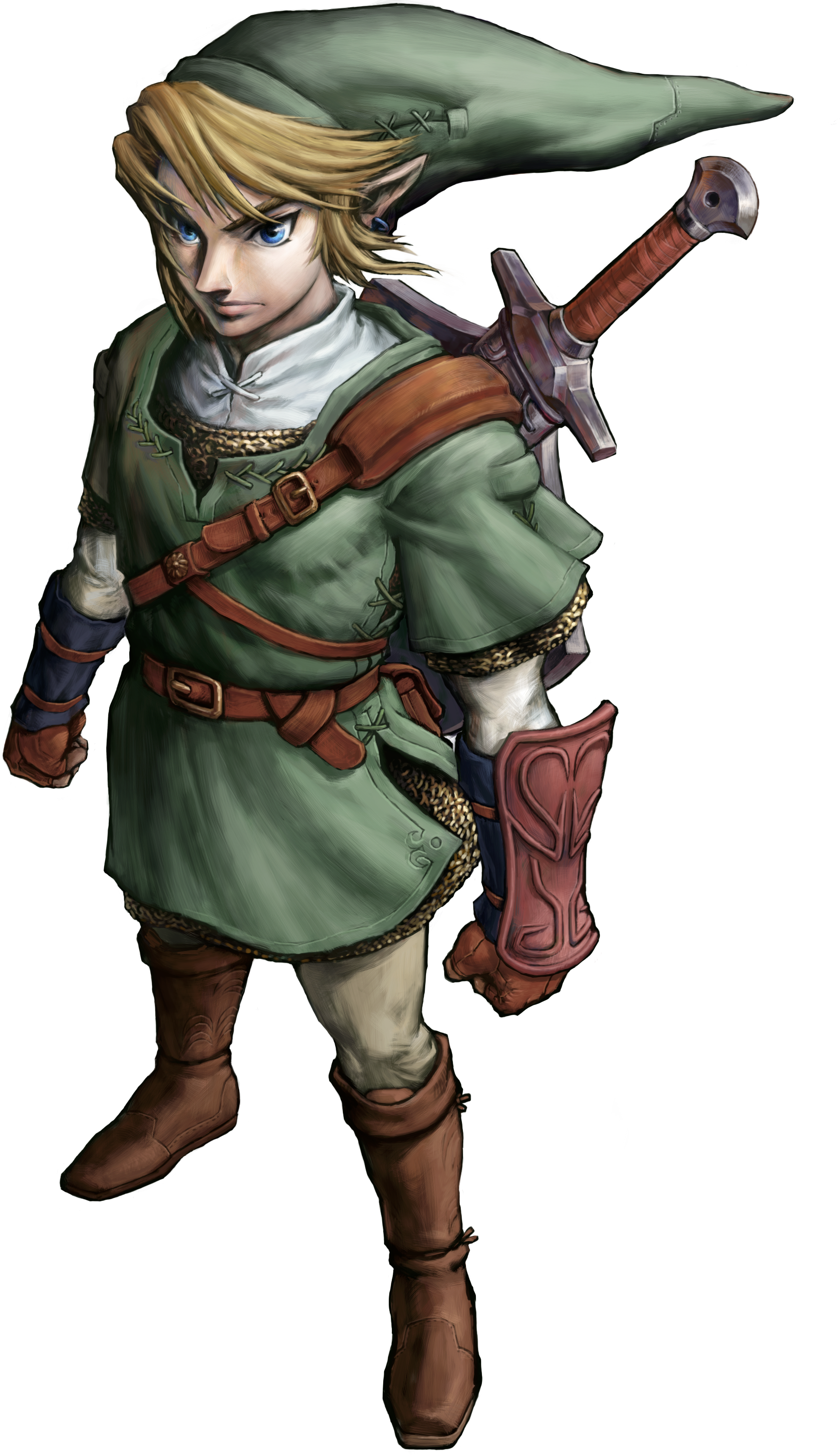
Image from Zelda Wiki.
In the games, this shirt almost looks like a stretchy, skintight, “Underarmor”-style shirt. However, that’s not exactly a fabric your typical Celt warrior had at his disposal, nor would it be something he would want to wear into battle—especially if he was wearing chainmaille.
While chainmaille is a wonderful, flexible armor that is perfectly suited to someone who needs protection but also plans on backflipping away from blows, it’s also fairly heavy and does little to block the impact of a blow. This is why any good medieval warrior wears a padded arming shirt under their chainmaille.
So, for my Link costume, I decided to go with the kind of arming shirt that I would expect Link to wear under his chainmaille. Since Link’s costume is typically described as an outfit passed down through the ages to the current hero, I figured this arming shirt would be a bit more like the arming shirts worn by Celtic royalty, so my shirt has darker fabric bands around the elbows and thread detailing.
In addition, rather than going with a classic steel ring chainmaille, I chose to use aluminum rings instead. I figured that Hyrule’s legendary hero would wear something more akin to Tolkien’s mithril. That way, Link would be both more protected and more agile in his armor.

Not the best photo ever, but this shot of a jump attack does a good job of showing off the arming shirt and chainmaille (which are often hard to see in most pictures).
Unfortunately, mithril doesn’t exist in this world, so aluminum was my best approximation. It’s not “hard as dragon scales”, but it is quite light and retains a better shine than steel, so it seemed like a good option.
All together, while my arming shirt isn’t exactly “game accurate”, it is accurate to what Link probably would have worn in real life. Combine the arming shirt with a real 4-in-1 (the ring style of Link’s in-game chainmaille) pattern chainmaille shirt and you have all the right layers and details to create a very believable warrior.
Link’s Bracer
Since Twilight Princess is the most realistic-looking game of the Legend of Zelda Franchise, I drew heavily on images from Twilight Princess for inspiration when creating my Link cosplay.
In Twilight Princess, Link wears a rather distinctive bracer on his right arm:

Image from Smashpedia
Now, if you’ve ever fenced or spent a decent amount of time fighting with swords, the benefits of a bracer like this should be immediately apparent. No matter how good you are with a sword, your hands, wrists and forearms get hit…a lot.
With that in mind, I decided that a bracer like this made a lot of sense for my Link cosplay. After all, it was just the sort of practical element you’d expect to see on a real life warrior.
At first, I thought about making a hardened leather bracer, but on closer inspection I concluded that Link’s bracer was actually a soft leather. The bracer itself covers the wrist to a degree (which is good, since a wrist injury can quickly take you out of a fight), but a hardened leather bracer can significantly impair your sword technique. That being said, most blows to the wrist are fairly mild, so a soft leather bracer would simultaneously protect Link without his limiting mobility.
So, I took a piece of 8 oz leather and carved the bracer design into the leather with a razor blade. Then, I took a beveling tool and scraped the leather down around the raised parts of the design.

Normally, you detail leather by carving out your design and using a stamping tool to smash the leather down around your designs. However, since I wanted this particular bracer to be light and flexible, I actually removed the leather to thin out the bracer some. This left me with a flexible, yet protective bracer that looked just like the one from Twilight Princess!
The Master Sword
Although I have mad respect for the amazing fiberglass, foam, wood and other weapons that many cosplayers make, I love real metal weapons. Yes, I can’t usually bring them to a cosplay event, which does undermine my costume’s look at Comic Con a bit, but for cosplay photos, nothing beats the look, feel and visible weight of a metal weapon.
Fortunately, when it comes to the Master Sword, there are a variety of full metal versions out there, so I didn’t have to make my own blade like Austin did for the Blade of Nimrodel. After some deliberation, I decided that I liked the look of this Master Sword:

Image from Amazon.com.
More than any other version of the Master Sword, I felt like this version had the right detailing and (most importantly) blade shape. I really love the look of this sword. The only downside is, while the blade looks great, it’s a ground metal blade that is very top-heavy and handles about like a warhammer.
I wouldn’t want to get hit by this sword, but it’s also very tiring to fight with for prolonged periods.
As you can see in the above picture, the hilt in this particular version of the sword is a metal gray, not the classic blue you see in the video games. There is a blue version of the sword, however, I opted for the gray version because Master Sword blue really isn’t something you see on medieval-era hilts.

Image from Amazon.
Let’s face it, a painted blue hilt just doesn’t scream, “This is what the Master Sword would look like in real life!”
That being said, even as a 12-year-old boy trying to imagine a real-life version of Link (yes, I started thinking about this costume the first time I played the game), I knew what the hilt would actually be made from: blued steel.
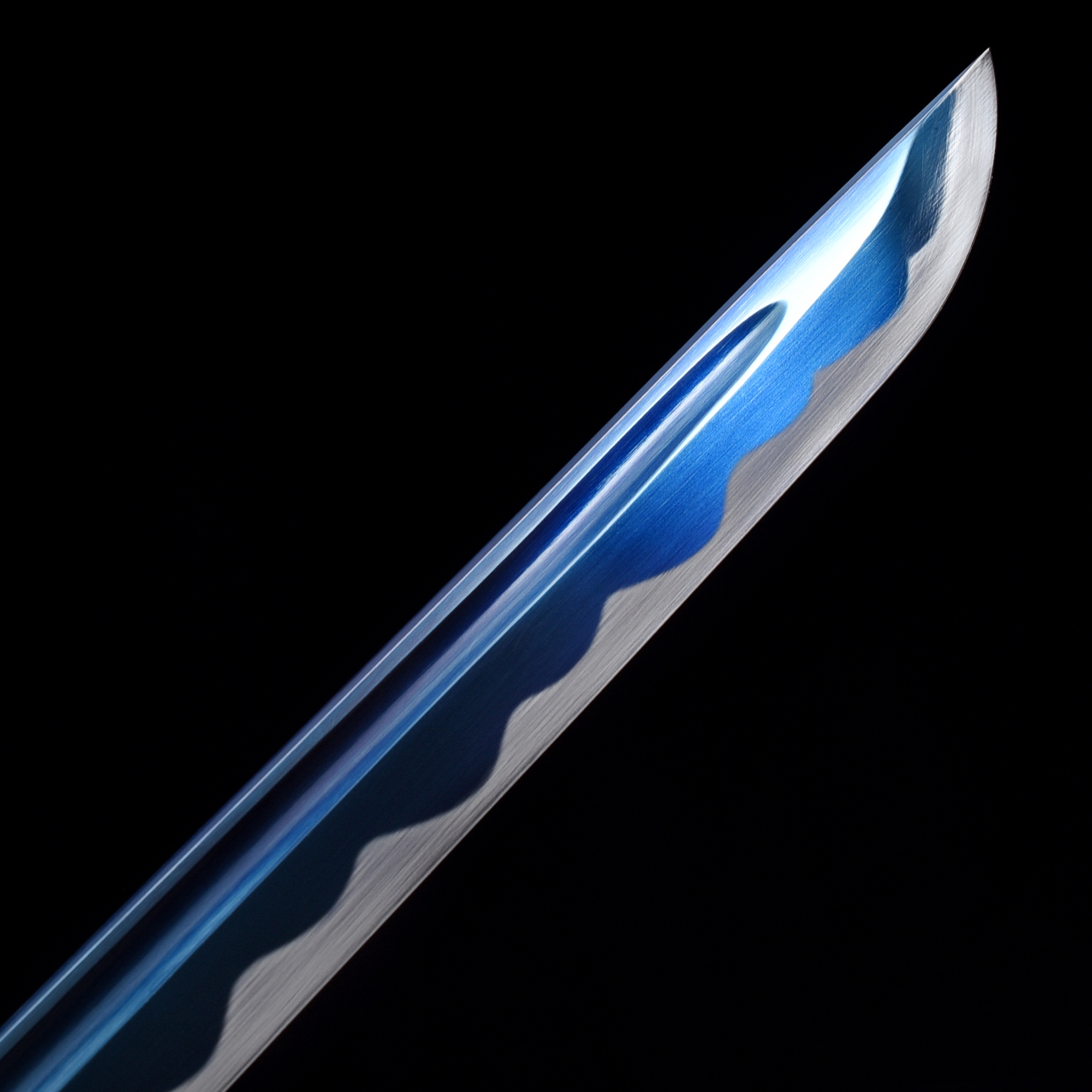
Hand-forged blue steel katana (image source).
Traditionally, bluing steel was a way of tempering and strengthening steel (seems appropriate for the Master Sword, right?). I’m not exactly sure whether or not swords were tempered this way by medieval Celts, but it’s a magic sword anyways, so I figured historical accuracy wasn’t completely necessary…
With a few tweaks, I was very happy with the way the Master Sword turned out. It had all the right detailing and looked about as realistic as you could ask for from a sword based on this design:

Now, as nice as my Master Sword looks, if you pay attention, I actually use a couple of other swords as well throughout the Legend of Zelda Cosplay Project.
The first is a licensed replica of Narsil, from Lord of the Rings. This sword is huge, so it made for a perfect Biggoron sword:
Over the years, I’ve decided that there is nothing quite so simultaneously amusing, fulfilling and epic as wielding a gigantic sword. It might not always be practical, but it’s always cool.
Second, I also use Kit Rae’s Sword of Vaelen from his Sword of the Ancient’s Collection (it’s no longer in production, but I picked it up years ago as one of the first swords in my collection):
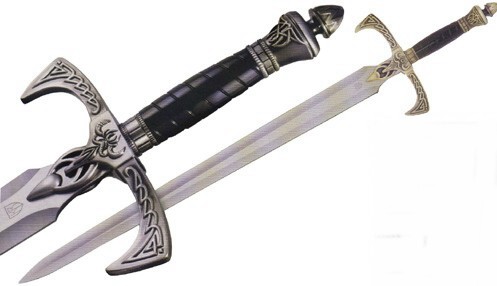
Sword of Vaelen (image source).
This sword has always been one of my favorites (probably because it looks so much like the Master Sword…) and I’ll admit that the detailing on this sword was an influencing factor in my decision to go with a Celtic feel for my Link cosplay.
In part, I used these additional swords as a tribute to the games, where Link typically uses a variety of swords before acquiring the Master Sword (for example, see the wear patterns photo in the tunic section). However, as I mentioned before, the Master Sword was a bit unwieldly, so I also used the Sword of Vaelen to improve my sword dexterity and give my forearms a break during prolonged shoots.
Link’s Shield
Of all the elements I put together for my Link cosplay, the shield easily required the most revisions to get right. From the outset, I knew that Link’s standard Hylian shield wasn’t going to fit the pragmatic, real-life cosplay I was designing.
First off, while the shield looks great in-game, it is clearly a ceremonial shield—not the kind of shield you’d want to wield in a pitched battle.
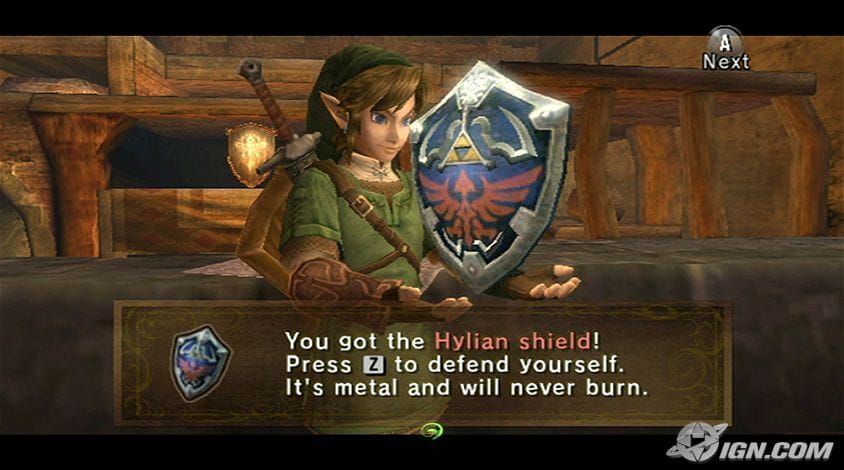
Second, most medieval shields were fairly simple. They were designed to do two things: protect and identify their wielder. To that end, your typical medieval combat shield had—at best—a fairly basic identifying crest.

Image from Lords and Ladies.
So, that meant an elaborate ceremonial shield that looked like the classic Hylian shield was out. Instead, I needed something simpler like the templar shield above.
However, I still wanted to evoke the general shape of the Hylian shield. To do that, I needed to modify a classic heater shield (same sort of shield as the one the knight is carrying in the picture above).
A heater shield has the right dimensions and curvature for Link’s shield and was historically used the same way that Link uses his shield. There’s only one problem: Link’s shield always has a pointed top and heater shields typically have a flat top (with the exception of ceremonial shields).
Even though I felt like a full ceremonial Hylian shield wouldn’t fit with my depiction of Link, I still wanted to give a nod to the Hylian shield. So, I found a steel heater shield and cut it into the right shape with a metal saw.
However, I still had a couple of problems. The shield I had gotten my hands on had no way to attach it to a scabbard (not a normal requirement for most shields). In addition, the shield had been painted black, which didn’t look like anything Link normally uses.
At first, I thought I would solve the black paint problem by painting over the black with a chrome paint. Unfortunately, after numerous attempts, I discovered that you can’t paint something into looking like metal. Instead, I had to painstakingly sand all of the paint off (including my newly added layers of chrome paint) to get down to the actual steel.
Once I had exposed the steel underneath the black paint, I added the Hylian crest (a nod the Hylian shield that I felt was consistent with the heraldic crests normally used as identifying marks on medieval shields) and ended up with a great-looking shield!
Ironically, while I designed this shield years before Breath of the Wild was released, the game designers apparently agreed with my artistic instincts, because the Knight’s Shield in Breath of the Wild is almost identical to my design!
Image from Zelda Fandom.
From there, all I had to do was get it onto my back. Since the goal of this whole project was to create a real-life approximation of Link’s outfit, this meant I had two more challenges: 1) how to get the shield to sit properly on my back and 2) how to get the shield on and off with relative ease.
Lining up Link’s Shield
The first problem has always been a particular sticking point for me with many Link cosplays. Here’s how Link’s shield sits on Links back in the games:
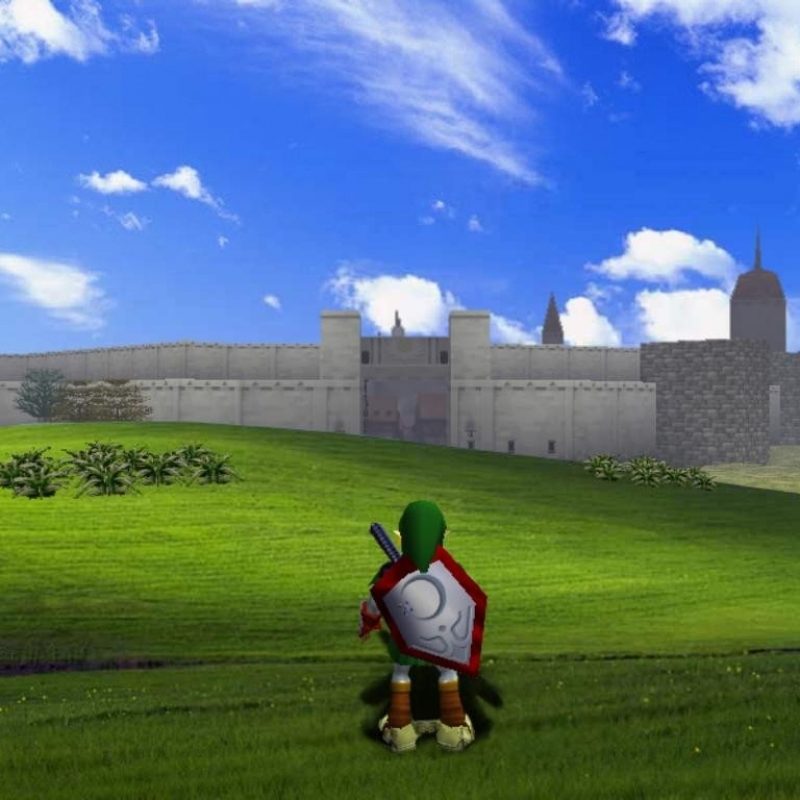
As you can clearly see from this screenshot, Link’s shield is aligned with the angle of the sword on his back. However, many Link cosplayers, including even some of the very best cosplayers, wear the shield straight up-and-down.

Original image by Adella.
I don’t know why, but this has always bugged me. You see it all over the place, even in commercial products. It’s a simple detail, but it makes a big difference in how the final cosplay looks, so I wanted to make sure that I got it right.
Fortunately, this proved to be a simple problem to solve. All I had to do was keep the top and bottom points of the shield aligned with the scabbard and the rest would take care of itself. This brought me to the second question, how should I attach the shield to the scabbard?
Attaching the Shield
Let’s face it, even in the absence of magic, games bend reality. In the Legend of Zelda franchise, Link pulls out his sword and shield (and various other items) in an instant and is ready to do whatever the player wants.
This is important for gameplay, but impractical for a cosplayer who is trying to bring a video game character to life.
I knew that I wouldn’t be able to replicate Link’s instantaneous battle-readiness, but I did want to do my best to approximate it. With that in mind, I wanted to be able to get my sword and shield out and ready within 5-10 seconds.
I’d spent years practicing how to smoothly get a sword in and out of an over-the-shoulder scabbard, but the shield was another matter entirely. Most of the quick-release mechanisms I could think of wouldn’t withstand the leaping, climbing and other abuse Link (and I) would be doing and more permanent attachments wouldn’t meet the “ready at the drop of a hat” criteria.
Both Austin and I toyed around with a variety of increasingly complex solutions, but ultimately, the idea I went with was surprisingly simple. I added leather straps with snaps (like the ones you use on a pair of pants) to the top and bottom of the shield that fit around the scabbard.
To get the shield on or off, all I had to do was open or close the snaps with one hand while holding the shield with the other. It is by no means as effortless as Link’s technique (whatever that is…), but it allowed me to quickly get the shield on and off. At the same time, the straps and snaps could handle all the punishment I had to dish out, whether that was running, climbing a cliff or leaping 8 feet to the ground.
The end result was a shield that looked great, sat right and met all of my performance criteria!
Everyone Hates Link’s Hat
Unfortunately, for a costume that was designed from the ground up to be a completely reasonable adventuring outfit, one problem kept the cosplay from being truly practical: Link’s hat.
I’m sure any cosplayer who has ever put together a Link costume would agree with me: Link’s hat is the worst.
As cool and iconic as his hat looks in-game, in real life, it’s just not practical to keep something like that on your head while fighting, jumping and rolling around (this may be part of the reason why Link doesn’t wear his classic nightcap in Breath of the Wild…).
The problem is, Link’s hat is basically designed to fall off. Link only wears it partially on his head to begin with and all the extra weight of the fabric in the nightcap just makes things worse.
Make it out of leather, add some fluff to give the hat the sort of body that Link’s hat has and then attach it all to a wig…and you have a recipe for disaster:
Even if you don’t outright lose the hat, it can still cause all sorts of issues:

Now, if I actually had thick blond hair like Link, I could probably have sewn the hat into my hair and everything would have been fine. But, since that wasn’t an option, Link’s hat was the only real problem I had in executing my real-life Link vision.
Conclusion
When it comes to bringing a character to life—especially a cartoon character—every cosplayer does it differently. For my Link cosplay, I envisioned Link as a manly Celtic warrior, the kind who could take on the worst that Ganondorf could throw at him and keep on coming.
That vision led to the Legend of Zelda Cosplay Project, where we ultimately tried to create a real-life version of the world of Hyrule. Sure, it’s not always a game-accurate version, but we tried to blend the real world and the imaginary one in a way that was truly believable.







